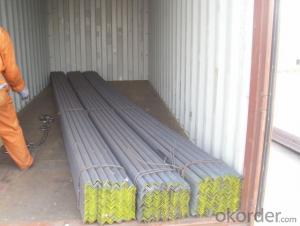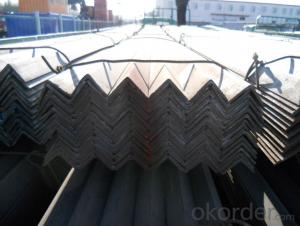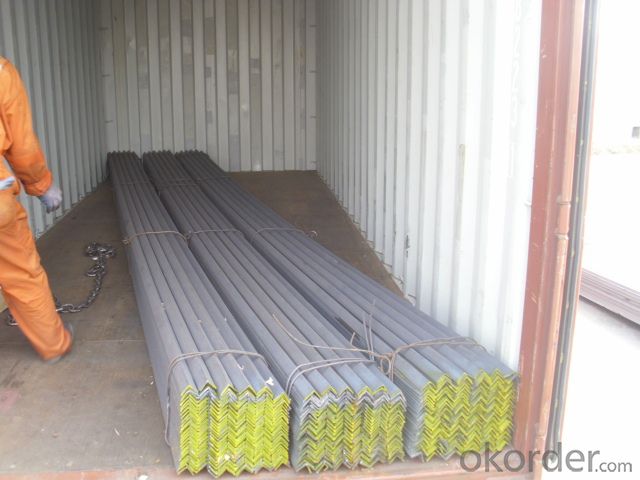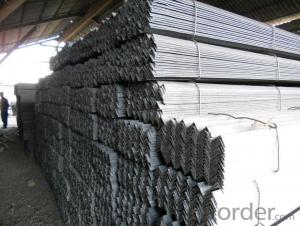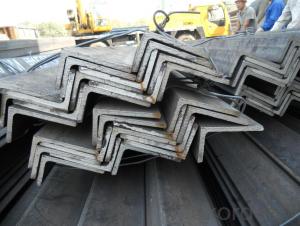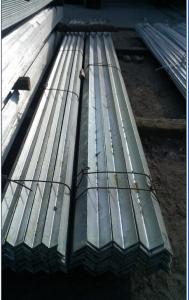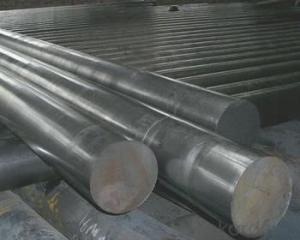Q235 Equal Steel Angle
OKorder Service Pledge
OKorder Financial Service
You Might Also Like
Specifications of Equal Angle Steel
1.Standards:GB
2.Length:6m,9m,12m
3.Material:GBQ235,Q345 or Equivalent
4. Size:
Size (mm) | Mass (mm) | Size (mm) | Mass (mm) |
| 30*30*2.5 | 1.16 | 30*30*3 | 1.373 |
| 30*30*2.7 | 1.246 | 30*30*4 | 1.786 |
Usage & Applications of Equal Anlge Steel
Trusses;
Transmission towers;
Telecommunication towers;
Bracing for general structures;
Stiffeners in structural use.
Packaging & Delivery of Equal Angle Steel
1. Transportation: the goods are delivered by truck from mill to loading port, the maximum quantity can be loaded is around 40MTs by each truck. If the order quantity cannot reach the full truck loaded, the transportation cost per ton will be little higher than full load.
2. With bundles and load in 20 feet/40 feet container, or by bulk cargo, also we could do as customer's request.
3. Marks:
Color mark: There will be color marking on both end of the bundle for the cargo delivered by bulk vessel. That makes it easily to distinguish at the destination port.
Tag mark: There will be tag mark tied up on the bundles. The information usually including supplier logo and name, product name, made in China, shipping marks and other information request by the customer.
If loading by container the marking is not needed, but we will prepare it as customer request.
*If you would like to get our price, please inform us the size, standard/material and quantity. Thank you very much for your attention.
- Q: What are the typical lengths of steel angles?
- The typical lengths of steel angles vary depending on the specific application and industry standards. However, common lengths for steel angles range from 20 to 40 feet.
- Q: What are the different types of steel angles available?
- Some different types of steel angles available include equal angles, unequal angles, and L-shaped angles. Equal angles have equal sides and are commonly used for structural purposes. Unequal angles have different side lengths and are often used for bracing or framing. L-shaped angles have one longer side and one shorter side, creating an L-shape, and are often used for corner and edge protection.
- Q: Are steel angles suitable for seismic design?
- Yes, steel angles are suitable for seismic design. They are commonly used in seismic design due to their ability to resist lateral forces and provide structural stability during earthquakes. The shape and strength of steel angles make them effective in transferring and distributing seismic loads, making them a reliable choice in seismic-resistant construction.
- Q: How do steel angles contribute to the durability of a structure?
- There are several ways in which steel angles contribute to the durability of a structure. Primarily, their high strength and ability to bear heavy loads make them a popular choice in construction. They provide additional support and stability to beams, columns, and trusses. Steel angles' rigidity and strength are crucial in ensuring that structures can withstand significant loads, impacts, and external forces. This is especially important for buildings exposed to extreme weather conditions, seismic activities, or high winds. By evenly distributing the load, steel angles prevent excessive deflection, bending, or deformation that could compromise the structure's integrity and longevity. Furthermore, steel angles' corrosion resistance makes them ideal for structures exposed to moisture, humidity, or harsh environments. Unlike other materials, steel does not rot, decay, or warp over time. It maintains its structural integrity for an extended period, reducing the need for frequent repairs and replacements. In addition to their strength and resistance to corrosion, steel angles contribute to a structure's durability due to their versatility. They can be easily customized and fabricated into different shapes and sizes, allowing for efficient construction and design flexibility. This adaptability ensures that steel angles can be effectively integrated into various architectural and engineering requirements, enhancing the overall durability and functionality of the structure. In conclusion, the use of steel angles significantly enhances the durability of a structure in construction. Their high strength, load-bearing capacity, corrosion resistance, and versatility all contribute to the overall stability, longevity, and structural integrity of the building. This ensures that the structure can withstand different challenges and maintain its durability over time.
- Q: How do steel angles perform under cyclic loading?
- Steel angles are widely used in various structural applications due to their excellent strength and stiffness properties. When subjected to cyclic loading, which refers to repeated loading and unloading cycles, steel angles perform exceptionally well. Under cyclic loading, steel angles exhibit a phenomenon known as fatigue, which is the progressive and localized structural damage that occurs when a material is subjected to repeated loading and unloading. However, steel angles have a high fatigue resistance, making them highly suitable for applications where cyclic loading is expected. The key factor contributing to the performance of steel angles under cyclic loading is their material properties. Steel, being a ductile and resilient material, is able to deform and absorb energy under cyclic loading, thereby preventing the accumulation of stress concentrations that could lead to failure. Moreover, steel angles are typically designed with a sufficient factor of safety to withstand cyclic loading without compromising their structural integrity. This ensures that they can endure numerous cycles of loading and unloading without experiencing significant deformation or failure. In addition to their inherent material properties, the structural design and fabrication of steel angles also play a crucial role in their performance under cyclic loading. Proper design, including consideration of the expected loading conditions and appropriate reinforcement, ensures that steel angles can withstand cyclic loading without experiencing excessive deformation or stress concentrations. Overall, steel angles are well-suited for applications involving cyclic loading due to their high fatigue resistance, ductility, and structural design considerations. Their ability to withstand repeated loading and unloading cycles makes them a reliable and durable choice in various structural systems.
- Q: What is the corresponding length of the root weight in the angle standard?
- General fixed length delivery without weighing, no fixed length delivery is generally applied to weighing sales. Profile fixed length is generally divided into 6 meters, 9 meters and 12 meters, special sizing must be large quantities, consultation with the steel supply.
- Q: How do steel angles perform in corrosive or acidic environments?
- Steel angles perform well in corrosive or acidic environments due to their inherent resistance to corrosion. The presence of alloying elements, such as chromium and nickel, in stainless steel angles enhances their corrosion resistance, making them suitable for such environments. Additionally, a protective oxide layer forms on their surface, providing further protection against corrosive elements.
- Q: Can steel angles be used for solar panel mounting?
- Yes, steel angles can be used for solar panel mounting. Steel angles provide a sturdy and durable framework to securely mount solar panels, ensuring stability and longevity in various weather conditions.
- Q: How do you inspect and measure the dimensions of a steel angle?
- To inspect and measure the dimensions of a steel angle, you can use various tools and techniques. Firstly, you can visually examine the angle to ensure it is free from any visible defects or deformities. Next, you can use a tape measure or calipers to accurately measure its length, width, and thickness. Additionally, a protractor can be used to measure the angle's degree of bend. To ensure precise measurements, it is recommended to repeat the process multiple times and take an average value.
- Q: Can steel angles be used in bridges?
- Yes, steel angles can be used in bridges. Steel angles are often used as structural elements in bridge construction due to their strength, versatility, and ability to provide support and stability. They can be used in various bridge components such as beams, trusses, and connections, helping to distribute loads and resist forces in bridge structures.
Send your message to us
Q235 Equal Steel Angle
OKorder Service Pledge
OKorder Financial Service
Similar products
Hot products
Hot Searches
Related keywords
